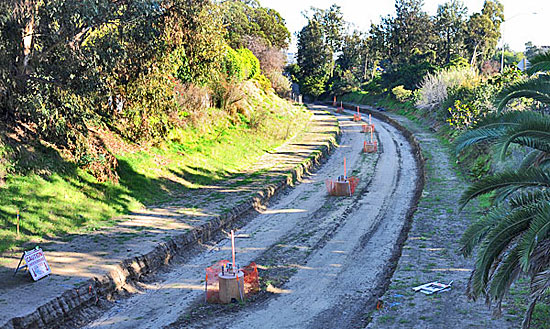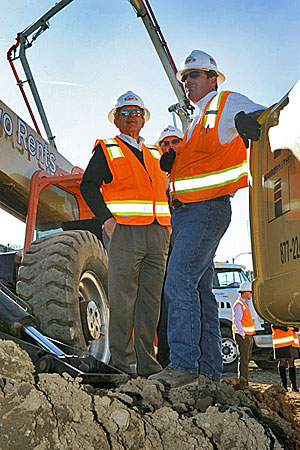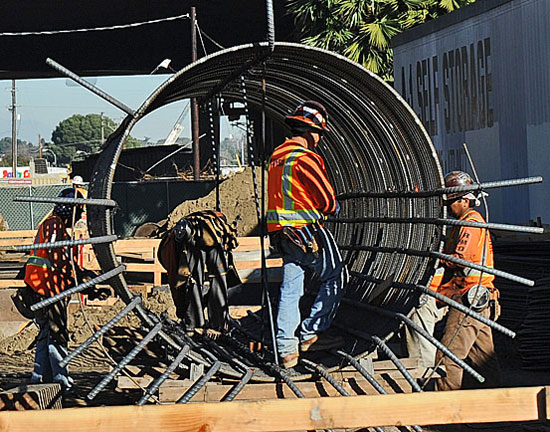Expo 2’s ahead of the curve
February 7, 2013

The Northvale Trench in Cheviot Hills, where Expo trains will run along a path blazed by their rail predecessors.
Maps and blueprints are fine, but there’s nothing like getting out into the real world and seeing the future take shape.
A few days ago, I had the opportunity to tour the second phase of the Expo Line, which is rapidly taking form along a corridor running from Culver City to Santa Monica.
It was remarkable. New bridges are rising, a once-abandoned railroad right-of-way is coming back to life and the contours of the project are emerging before our eyes.
The thrill of going behind the scenes in the construction zone was kind of like seeing a prenatal sonogram: Expo Phase 2 is still a long way from the delivery room, but this baby’s shaping up beautifully.
When the 6.6 mile stretch is finished in 2015—with a final station just a short walk from the Pacific Ocean—it will complete the light rail line that’s now carrying more than 23,000 passengers a day between downtown Los Angeles and Culver City. It will offer a true alternative to the heavily congested Santa Monica Freeway that it parallels for much of its route.
And it will mark another crowning achievement in what I consider the golden era of public transportation infrastructure development in the Los Angeles region.
Think about it: in just the last 10 to 15 years, we’ve built a subway to the San Fernando Valley, forged light rail connections to Pasadena, East Los Angeles and Culver City, and created two legs of the Orange Line rapid transit busway that now runs from North Hollywood to Chatsworth. Workers currently are constructing a new stretch of the Gold Line from Pasadena to Azusa, and work should be starting on the Crenshaw Line to LAX in the not-too-distant future. We’re also preparing to extend the subway to the Westwood V.A. and to build a Regional Connector downtown to help tie it all together.
As we’ve grown the system, the whole has proven to be much bigger than the sum of its parts, offering a bustling network of region-wide connections that would have been unthinkable a generation ago.
In our notoriously sprawling and supposedly car-dependent region, we’ve shown that Angelenos aren’t wedded to their automobiles and in fact are more than willing to vote with their feet if we can offer alternatives to an increasingly clogged freeway system.
I fully expect them to beat a path to the Expo Line when it’s complete. I’m not just talking about folks who live on the Westside but also the thousands throughout the region who commute there for jobs and recreation.
From what I saw during my tour, it’s clear that this line will offer them more than just a great escape from traffic on the 10. It also will provide a bargain tour of Los Angeles rarely glimpsed through the windshield of a car. It includes a sylvan stretch in Cheviot Hills where the Red Car once ran, panoramic views from bridges and elevated platforms along the route, and a middle-of-the-street trip through the pleasant urbanscape of Colorado Boulevard before it concludes at 4th Street and Colorado, just across from Santa Monica Place and down the street from the Pier.
Construction projects, of course, are highly unpredictable but I’m happy to report that this one, for now, is on time and on budget—maybe even a little ahead of the game.
But we can’t afford to let up.
Funding for Expo Phase 2 and other projects comes from Measure R, the ½-cent sales approved by 68% of county voters in 2008. Disappointingly, efforts to extend the sales tax for another 30 years—making it possible to get moving sooner on an array of transportation projects—failed at the ballot box this past November.
The extension, known as Measure J, lost even though it received 66.11% of the vote because of an anachronistic provision in our state constitution requiring two-thirds voter approval for such measures.
This needs to change.
So as construction teams work to finish Expo, efforts are building in Sacramento to try to move the approval threshold from two-thirds to a still-difficult but more reasonable 55%.
I hope that the state’s voters are ready for the change, and for the improvements in transportation infrastructure it could generate.
Because here in Los Angeles, we’re building a transit system that will benefit our region for generations. And we have no intention of turning this train around now.
Posted 2/7/13














 405 bridge work causes a stink
405 bridge work causes a stink





